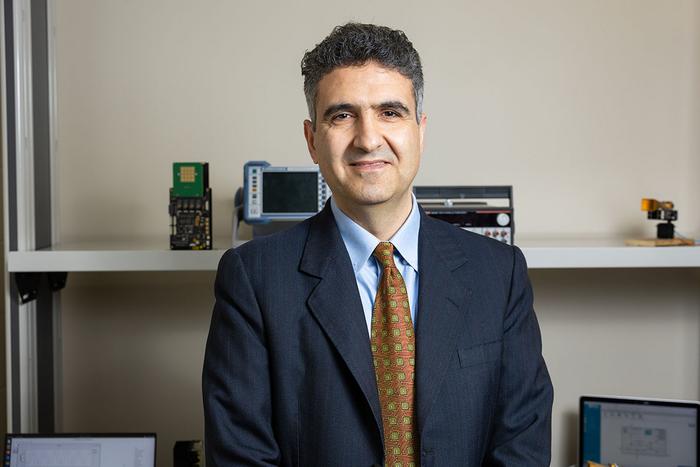Communicating unimpeded at distances near and far is a dream Murat Yuksel is hoping to realize.

Credit: Photo by Antoine Hart
Communicating unimpeded at distances near and far is a dream Murat Yuksel is hoping to realize.
His ongoing research, titled “INWADE: INtelligent Waveform Adaptation with DEep Learning,” and funded by the U.S. Air Force Research, aims to get us closer to that dream by improving the quality of high frequency wireless networks using machine learning to fine-tune the networks’ efficacy.
The need to efficiently improve wireless signal quality will grow with the continuing proliferation of wireless networks for use in communications, says Yuksel, who is a UCF Department of Electrical and Computer Engineering professor within the College of Engineering and Computer Science.
“The emerging 5G-and-beyond wireless networks regularly use high frequency signals that are very sensitive to the environment,” he says. “They get blocked easily or attenuate quickly as they travel. Even the nature of the particles in the air affects them significantly. Deep learning enables us to learn the features of the environment. Hence, using these learned features enables us to better tune the wireless signals to attain higher data transfer rates.”
INWADE is an automated means to design multiple communication blocks at the transmitter and the receiver jointly by training them as a combination of deep neural networks, benefitting wireless network users.
The development and study of the INWADE network was catalyzed by the need to keep pace with the spread and usage of wireless networks.
“Demand for wireless data transfers (such as cellular and Wi-Fi) is ever-increasing and this causes more tussle on the sharing of the underlying natural resource, which is the radio spectrum that supports these wireless transfers,” Yuksel says.
The deep learning aspect of the research is an emerging consideration delivering better wireless signals with minimal delay. The deep learning network will select the optimal waveform modifications and beam direction with its perceived radio frequency environment to manage drones and nodes providing wireless signals and modifications.
“Our work shows the feasibility of using deep reinforcement learning in real time to fine tune millimeter-wave signals, which operate in part of the super-6 GHz bands,” Yuksel says. “Further, the project aims to show that deep learning at the link level as well as network level can work together to make the signals ‘deep smart.’”
Harnessing existing wireless networking resources and navigating fixed obstacles or crowded airways quickly is an omnipresent concern and leads network managers to search for spectra at higher frequencies than the commonly used sub-6 GHz frequency bands, Yuksel says.
These “super-6 GHz” bands are difficult to access and maintain, so deep learning is something Yuksel is hoping to use to address that challenge.
“They operate with highly directional antennas, which makes them brittle to mobility/movement and they cannot reach far as they are sensitive to particles in the air,” Yuksel says. “Hence, we have to handle them very carefully to support high-throughput data transfers. This requires advanced algorithmic methods that can learn the environment and tune the super-6 GHz wireless signals to the operational environment.”
Some initial findings regarding the viability of algorithms that may be implemented in INWADE were published at the International Federation for Information Processing Internet of Things Conference in late 2023.
The project started earlier in 2024 after receiving the first portion of the awarded $250,000 from the Air Force Research Laboratory in late 2023, but there already are promising findings, Yuksel notes.
“We have shown in a lab testbed that our deep learning methods can successfully solve some of the fundamental link level problems, such as angle-of-arrival detection or finding the direction of an incoming signal,” he says. “This capability is very useful for several critical applications, for example determining location and movement direction. Next steps include demonstrating similar capability on drones and showing the feasibility of co-existence of deep learning at the link and network levels.”
After developing and testing the INWADE framework, Yuksel foresees additional challenges and considerations that may require further study when implementing machine learning.
“A key theoretical endeavor is to understand if multiple machine learning agents can co-exist at different layers of the wireless network and still attain improved performance without jeopardizing each other’s goals,” he says.
Although Yuksel is the principal investigator for the research, he credits his students and collaborators for much of his success.
“My students help in performing the experiments and gathering results,” he says. “I am indebted to them. We are also collaborating with Clemson as they are working on designing new machine learning methods for the problems we are tackling.”
Yuksel’s work continues, and he is optimistic that his research will further benefit the greater scientific endeavor of making wireless networks accessible for all.
“The potential for this effort is huge,” he says. “I consider the radio spectrum to be a critical natural resource, like water or clean air. As machine learning methods are advancing, being able to use them for better sharing the spectrum and solving critical wireless challenges is very much needed.”
Distribution A. Approved for public release: Distribution Unlimited: AFRL-2024-2894 on 17 Jun 2024
Researcher’s Credentials
Yuksel is a professor at UCF’s Department of Electrical and Computer Engineering and served as its interim chair from 2021 to 2022. He received his doctoral degree in computer science from Rensselaer Polytechnic Institute in 2002. Yuksel’s research interests include wireless systems, optical wireless, and network management, and he has multiple ongoing research projects funded by the National Science Foundation.



